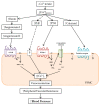Mechanisms Involved in the Relationship between Low Calcium Intake and High Blood Pressure
- PMID: 31109099
- PMCID: PMC6566648
- DOI: 10.3390/nu11051112
Mechanisms Involved in the Relationship between Low Calcium Intake and High Blood Pressure
Abstract
There is increasing epidemiologic and animal evidence that a low calcium diet increases blood pressure. The aim of this review is to compile the information on the link between low calcium intake and blood pressure. Calcium intake may regulate blood pressure by modifying intracellular calcium in vascular smooth muscle cells and by varying vascular volume through the renin-angiotensin-aldosterone system. Low calcium intake produces a rise of parathyroid gland activity. The parathyroid hormone increases intracellular calcium in vascular smooth muscles resulting in vasoconstriction. Parathyroidectomized animals did not show an increase in blood pressure when fed a low calcium diet as did sham-operated animals. Low calcium intake also increases the synthesis of calcitriol in a direct manner or mediated by parathyroid hormone (PTH). Calcitriol increases intracellular calcium in vascular smooth muscle cells. Both low calcium intake and PTH may stimulate renin release and consequently angiotensin II and aldosterone synthesis. We are willing with this review to promote discussions and contributions to achieve a better understanding of these mechanisms, and if required, the design of future studies.
Keywords: blood pressure; calcium intake; parathyroid function; renin-angiotensin-aldosterone system; vitamin D.
Conflict of interest statement
The authors declare no conflict of interest.
Figures



References
-
- Belizán J.M., Villar J., Self S., Pineda O., González I., Sainz E. The mediating role of the parathyroid gland in the effect of low calcium intake on blood pressure in the rat. Arch. Latinoam. Nutr. 1984;34:666–675. - PubMed
Publication types
MeSH terms
Substances
Grants and funding
LinkOut - more resources
Full Text Sources
Medical

